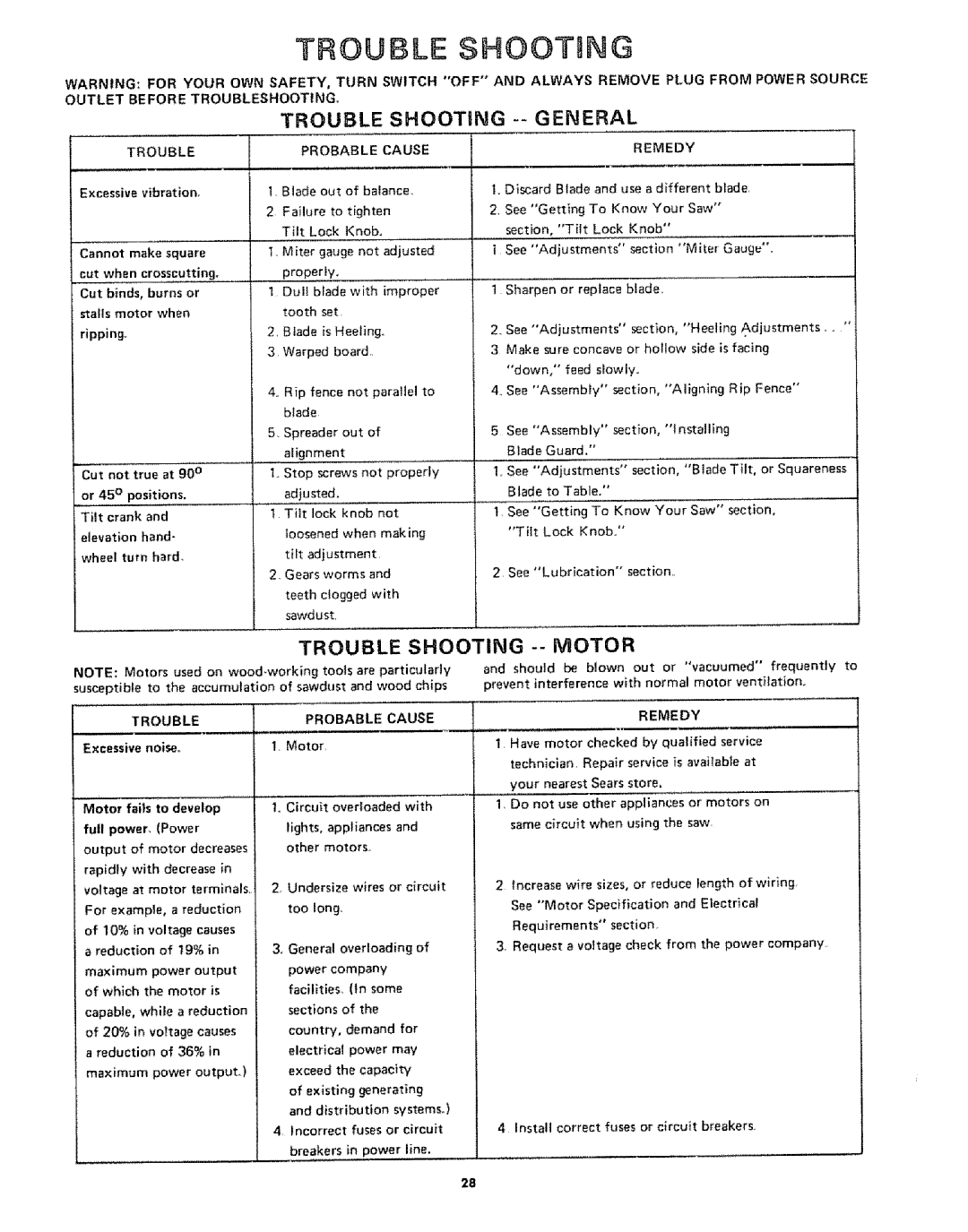
TROUBLE SHOOTRNG
WARNING: FOR YOUR OWN SAFETY, TURN SWITCH "OFF" AND ALWAYS REMOVE PLUG FROM POWER SOURCE
OUTLET BEFORE TROUBLESHOOTING,,
TROUBLE SHOOTING -- GENERAL
TROUBLE
Excessive vibration.
Cannot make square
cut when crosscutting. Cut binds, burns or
stalls motor when
ripping.,
PROBABLE CAUSE
, | ,, i ,,,,,,,,,u | , ,,, |
I. Btade out of balance.
2 Failure to tighten Tilt Lock Knob.
t. Miter gauge not adjusted
properly.
I Dull blade with improper tooth set
2, Blade is Heeting_ 3 Warped board,
REMEDY
l, | Discard | Blade | and | use | a different | blade, |
|
|
| |||
2, See "Getting To Know Your Saw" |
|
|
|
| ||||||||
| section, | "Tilt | Lock |
| Knob" |
|
|
|
|
| ||
t | See | '"' " |
| " |
| '""'"'"'";"i | l '_''u | _" | ,, | |||
Adjustments |
| section | M [e | L_a g |
|
| ||||||
1 | Sharpen | or replace |
| blade, |
|
|
|
|
| |||
2. | See | "Adjustments" |
| section, | "Heeling Adjustments | .... " | ||||||
3 | Make sure concave |
| or | hollow | side | is facing |
|
| ||||
| "down," | feed | slowly. |
|
|
|
|
|
| |||
Cut not true at 90 °
or 45 ° positions.
Tilt crank and
elevation hand-
wheel turn hard.
4, Rip fence not parallel to blade
5, Spreader out of
alignment
...... Stop screws not
adjusted.
1 Tilt lock knob not loosened when making tilt adjustment,
2, Gears worms and
teeth clogged with sawdust,
4, See "Assembly" | section, "Aligning | Rip Fence" |
5 See "Assembly" section, "Installing Blade Guard,"
1, See "Adjustments" section, "Blade Tilt, or Squareness Blade to Table."
1.See "Getting To Know Your Saw" section, "Tilt Lock Knob.,"
2 See "Lubrication" section
TROUBLE SHOOTING -- MOTOR
NOTE: Motors used on
susceptible to the accumulation of sawdust and wood chips
and should be blown out or "vacuumed" frequently to
prevent interference with normal motor ventilation,.
TROUBLE
H,
Excessive noise°
Motor fails to develop
full power. (Power
output of motor decreases rapidly with decrease in voltage at motor terminals, For example, a reduction of 10% in voltage causes a reduction of 19% in maximum power output of which the motor is
capable, while a reduction of 20% in voltage causes a reduction of 36% in
maximum power output.)
PROBABLE CAUSE
!Motor,
1o Circuit overloaded with lights, appliances and other motors
2.Undersize wires or circuit too long.
3.General overloading of
power company facilities, (in some sections of the country, demand for electrical power may exceed the capacity
of existing generating
and distribution systems.)
4 Incorrect fuses or circuit breakers in power line.
REMEDY
1 Have motor checked by qualified service technician, Repair service is available at
your nearest Sears store.
1_ Do not use other appliances or motors on same circuit when using the saw
2 Increase wire sizes, or reduce length of wiring,
See "Motor Specification and Electrical
Requirements" section
3. Request a voltage check from the power company
4 Install correct fuses or circuit breakers.
28
